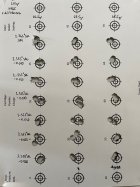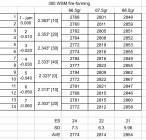I decided to run Tony Boyer’s target test to evaluate a brand new 300 WSM barrel.
I had only fired five rounds to zero the scope and check the group, so the barrel and brass were new and I was fire-forming during the test. I also don’t normally shoot from the bench, which made positioning a bit challenging.
Rifle: F-Class Open with a 31.50" barrel. Range: 100 m (110 yd). There was some mirage but nothing heavy.
I tested N555 at 63.0 gr, 63.5 gr and 64.0 gr.
For seating depth I found my hard jam point and loaded two rounds for each from +0.003" (in the jam) to -0.015" (away from jam).
I realize this is not perfect textbook run but any observations or helpful explanations about the group patterns would be greatly appreciated.
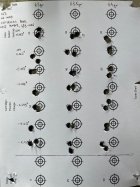
Also, if anyone could comment (second picture) on this observation: I noticed that in some groups (marked diagonally), it seems that when the charge is reduced, the seating depth may also need to be adjusted.
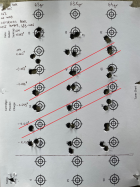
Here is also some chronograph data if you need it:
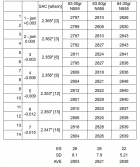
Lastly, is there still something to be learned from this, even though I know the test wasn’t done perfectly?
I had only fired five rounds to zero the scope and check the group, so the barrel and brass were new and I was fire-forming during the test. I also don’t normally shoot from the bench, which made positioning a bit challenging.
Rifle: F-Class Open with a 31.50" barrel. Range: 100 m (110 yd). There was some mirage but nothing heavy.
I tested N555 at 63.0 gr, 63.5 gr and 64.0 gr.
For seating depth I found my hard jam point and loaded two rounds for each from +0.003" (in the jam) to -0.015" (away from jam).
I realize this is not perfect textbook run but any observations or helpful explanations about the group patterns would be greatly appreciated.

Also, if anyone could comment (second picture) on this observation: I noticed that in some groups (marked diagonally), it seems that when the charge is reduced, the seating depth may also need to be adjusted.

Here is also some chronograph data if you need it:

Lastly, is there still something to be learned from this, even though I know the test wasn’t done perfectly?











